Marc Weidenbaum's Blog, page 98
June 7, 2023
Junto Profile: Ray Cobley
What’s your name? Ray Cobley (Raymond C.A. Cobley)
Where are you located? Stromness, Orkney Islands, Scotland. I have lived in Orkney for most of my adult life, including around 20 years on the small island of Sanday. Before that I moved around a lot, living in various places in the UK from childhood on, also spending some years in Germany, Austria, and Spain. In my youth I studied languages, gaining a master’s degree in German literature and a diploma in Spanish. I have had various occupations in teaching, agriculture, and retail, mainly on a self-employed basis. These days I am retired from paid work.
What is your musical activity? I kept the previous section brief because it has little direct bearing on my current activities. Throughout all the various stages in my life, music has been a constant and continuous thread. I had a solid basic grounding in music theory and have played (or played around with) various instruments. I never had the time nor the obsessive dedication required to be a high-grade performer and I was perhaps more interested in improvising than in reading or performing scores.
During my lifetime I have listened to many thousands of hours of music, mainly classical. In my youth I voraciously absorbed works of mainstream composers but later gravitated toward the modern era, including jazz. In addition, I also enjoy early music, including Renaissance polyphony and Bach.
My own first efforts at sound art and composition began some time after my introduction to digital technology and online resources, which enabled me to intensify my listening and studies of modernist music. I began with various attempts at musique concrète. I acquired a digital sound recorder and wandered around capturing various sounds, anything from birdsong to building sites, together with recordings of domestic activities or apparatus, of small and found instruments, etc. At the same time I was investigating techniques and software with which to play around with the recordings I had made and published my first tracks online around 12 years ago. Since that time I have expanded my capabilities and resources. These days, although I still often use the techniques of musique concrète and recorded sounds, much of my work is purely electronic.
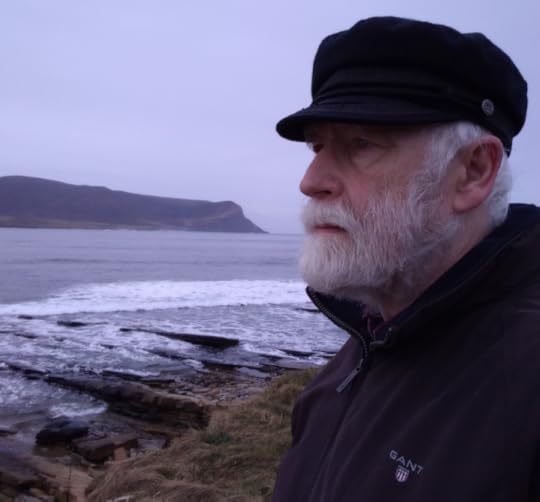
I have no room in my dwelling for banks of electronic apparatus or large musical instruments so that, together with small instruments, my equipment consists of laptops with Linux or Mac OS, with which I always use open-source software, for example: Pure Data (or “Purr Data” in its latest incarnation), Audacity, with hundreds of VSTs and plug-ins, PaulXStretch, and Samplebrain. I have an infinite array of sounds at my fingertips, both recorded and electronic. The challenge is to organize a few of them into interesting combinations and sequences.
It is not my intention to limit myself to one specific style or genre and I am ready to try anything that falls within the bounds of my competence. For this reason the Disquiet Junto perfectly chimes in with my activities. I also take part in the Naviar Haiku projects and, in addition to the music, have contributed the odd poem.
Some years ago it occurred to me that I could produce videos to post my music on sites such as YouTube and Vimeo, and I began to make fairly basic abstract animation to accompany the sounds. Gradually there came to be more of an equal balance between music and video. Now I often create the visual element before adding an appropriate soundtrack. I occasionally use music from Disquiet or Naviar projects in these videos, but more often than not the soundtracks are completely different and created specifically for use therein.
What is one good musical habit? Never discard or delete unpublished material, however unsatisfactory it seems. You never know if it might come in useful in a future project. There are no mistakes in composition: it is what you make it.
What are your online locations? I am not a huge fan of social media, although I do use Facebook from time to time. My music is available at soundcloud.com/ray_cobley and hearthis.at, videos at YouTube and Vimeo, music and videos at the Internet Archive (archive.org). All my work is published under a Creative Commons license and is free to download or remix.
What was a particularly meaningful Junto project? Rather than trawl through all my tracks and ponder over this for hours, I’ve chosen something fairly recent:
I have selected this because it presented a new challenge to me. I have no interest in dance music and, until I did some research, was not even sure about the exact characteristics of techno. In the end I was reasonably satisfied that I had created something slightly unusual or different in what I imagine can be a formulaic genre.
If I’m not mistaken, where you live is fairly isolated. Has the internet increasingly diminished any sense of isolation and provided a sense of community, in contrast with during your youth? With regard to quality of life, the Orkney Islands regularly feature among the best in the UK as a place to live. On the other hand, being distant from major conurbations and with a total population of around 22,000, the audience for my work is virtually non-existent here. A few years ago I arranged a presentation in a local gallery but hardly anyone turned up. Since this seemed to be a waste of my time and resources, I have not tried again. In other words, I depend on the internet to make connections. Fortunately, through the various online platforms and projects such as the Disquiet Junto, both as creator and listener, I certainly feel part of a vibrant international community.
As for my youth, life was so different in those days that I find it
impossible to make comparisons.
Did you learn the lesson about not discarding anything the hard way? That is, do you have a memory of having thrown out something and later regretted the decision? Yes, that did occur a few times and occasionally I still delete tracks in error. By the same token, once something is published I try to make sure that I remove it from other files. I once found that I had uploaded the exact same track twice on SoundCloud under different titles!
The sounds in your beautiful recent YouTube piece, “Palette (Pure Data),” sound like field recordings to a degree — like fog horns, but transformed. When you are making sound from scratch in Pure/Purr Data, does your work with field recordings inform it? Upon consideration, I make little distinction between recorded and electronic sounds in the processes of composition. The origin of the material is less important than its destination. In other words, the main value is in the intrinsic characteristics of each sound or sequence and its potential for development or inclusion in a given work and, like many other artists, I often combine sounds from various sources in a single track. Looked at in another way, electronic sounds can be made to resemble recordings (as you suggest above) or vice versa.
Pure Data is a multi-faceted and highly adaptable tool and it is certainly possible to create sounds which simulate some that are heard in nature or field recordings. I have made use of this from time to time and, of course, on occasion such sounds can arise quite unintentionally. Any sound file can also be imported into Pure Data for use in conjunction with electronics but this facility is probably more useful in live performance.
In general terms, since I started with field recordings and musique concrète, there is no doubt that my experience with them has informed my later work in the sense that I have continued to use many of the structural and manipulative techniques and processes I learned at that time with all other sounds.
June 6, 2023
Sound Ledger (Childcare Issue)
35: Percent faster that toddlers fell asleep in nurseries when classical music was played in a study
19: Percent faster for preschoolers
25,000,000: Fine, in $US, Amazon was hit with for the Alexa voice assistant reportedly violating child privacy
Sources: sleep (npr.org — thanks, Rich Pettus!), Alexa: (boston.com). And yes, “classical music” is a broad term. Presumably they weren’t playing Rachmaninoff.
June 5, 2023
Studying “Maths”
I’ll have a longer review of this when the album is released, but in the meanwhile, I highly recommend a preview listen to the forthcoming Myuthafoo by Milan, Italy–based musician Caterina Barbieri. It’s a gorgeous, varied collection, 6 pieces, 32 minutes, zero vocals. The album is quite extroverted at times — full-bodied synthesizer compositions that are best heard loud, such as “Math of You,” a hypnotic array of patterns that’s one of the two tracks available for advance listening. The other preview track is quite different, “Swirls of You,” with which the album closes. The song would make perfect sense with the Cure’s Robert Smith singing on top of it. But since he isn’t, you can enjoy Barbieri’s lush instrumental all on its own.
June 4, 2023
A B Testing
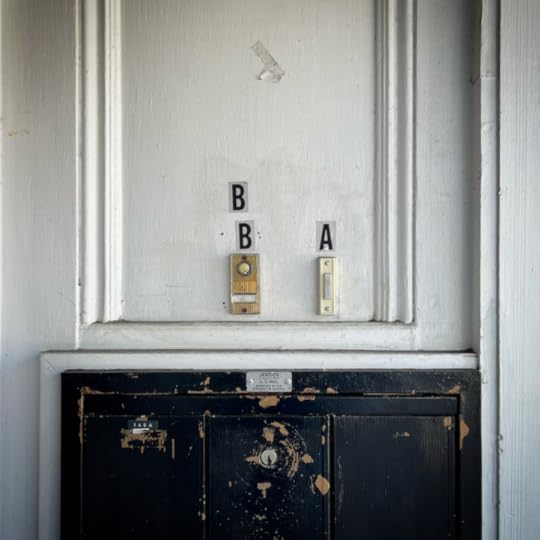
More illustrious mysteries from the paradigmatic intersection of design, interface, sound, and interaction: the domestic doorbell. The A button is to the right, the B to the left. There are, for reasons beyond comprehension, not one but two Bs and they are identical stickers. If the garage becomes a tenant unit, does it get three Cs? The buttons differ in size, shape, and color, and are both old enough that it’s initially unclear which came first. My money is on B having preceded A. I sense that the A is a long ago quick fix from when the more ornate B-style button broke. Note as well the discoloration around the buttons — is that from repairing, or handprints of visitors with bad aim? And then the icing on top is that little bit of tape above the doorbells, which no doubt displayed some version of the now common scrawled instructions for visitors — you know, to hit both buttons, or call this number, or check with the neighbor. That sign is gone but the adhesive remains. And that is, as well, a metaphor for so much in this troubled realm.
June 3, 2023
“A Preliminary Theory of Sound Design”
I spent some time last Sunday afternoon with Nathan Ho, a San Francisco Bay Area musician, coder, and educator whose name you may recognize from his gorgeous, sound-producing, complex Venn diagrams, which I wrote about at the start of 2021. ( served as the “cover” for this issue.) I mention him here not as a log of my social calendar, but because of something he wrote toward the end of last month on his excellent blog. It’s an essay that collates his thoughts on the underpinnings of sound design. He breaks the concepts down into nine “traits.”
The piece takes as its title and he notes Disney’s “12 Principles of Animation” as a model. The traits are, in alphabetical order: Contrast, Directionality, Fidelity, Regularity, Space, Transients, Verticality, and Vocals. They appear in a different sequence in Ho’s post, beginning, appropriately, with Transients (specifically the “initial” transient: “A tiny click,” he writes, “or burst of noise added to an attack, or a fade in, can make a huge difference”) and closing with Verticality (which he associates with other concepts, such as “arrangement” and “layering”). Whether you make sound or just think about it, the divisions he points out provide a useful classification system.
After reading it, you might try the following exercise: consider a sound, and then break it down into the eight traits that Ho has delineated. If you do, please report back.
Scratch Pad: Files, Jingles, Interfaces
I do this manually each Saturday, usually in the morning over coffee: collating most of the little comments I’ve made on social media, which I think of as my public scratch pad, during the preceding week. These days that mostly means post.lurk.org (Mastodon).
▰ How many times have I (re)learned that the best way to make sure that music files remain associated with each other as subsets of a given album in Apple Music (slash iTunes Match) is to make sure they’re MP3s or ALAC?
▰ I can hear but I don’t see the ice cream truck
▰ I’ve been trying out Duolingo for German. I assume this image means I’ll soon be reading Doepfer and Ableton synthesizer documentation in the original.

▰ Today’s near-paperless office: six screens, one tiny notebook
▰ Notifications settings:

▰ Digital-based note-taking can generate idiosyncratic cadences and processes. Today is the second day of the month. The second day of the month is the first day of the month when I need to have a document specific to the month, because my notes from my general daily note-taking, from yesterday, only became archival (historical) today. I create a new monthly doc to put those note in. Now, because I’m using IA Writer, which doesn’t sync seamlessly with Dropbox, I move the previous month’s monthly doc back into Dropbox, within a folder for the year, and then create a new monthly doc in its place within IA Writer (by “within” I just mean in an app-specific folder in iCloud). As always, some systems are simple; others reflect the accrual of habits as constrained by unique aspects of one’s perceived needs, discomforts, and priorities, which also shift and evolve over time. The latter are especially difficult to unpack after the fact. The main reality check is that this all took about two seconds to accomplish. Describing it took much longer.
June 2, 2023
Summer Hours
Summer (i.e., the end of the school year) begins today. I’m going to try to give myself a little more time between now and mid-August for recuperation and what we now call “long form” writing. This may mean I’ll take the occasional issue off (of This Week in Sound), and maybe even an occasional blog post. The Disquiet Junto will continued unabated. To wit, there likely won’t be an issue of This Week in Sound on June 9 (next Friday). Then again, it may come naturally and quickly. We’ll see. Writing this newsletter is generally more of a release than a chore, that’s for sure.
June 1, 2023
Disquiet Junto Project 0596: Phylogeny Junto

Each Thursday in the Disquiet Junto music community, a new compositional challenge is set before the group’s members, who then have just over four days to upload a track in response to the assignment. Membership in the Junto is open: just join and participate. (A SoundCloud account is helpful but not required.) There’s no pressure to do every project. It’s weekly so that you know it’s there, every Thursday through Monday, when you have the time and interest.
Deadline: This project’s deadline is the end of the day Monday, June 5, 2023, at 11:59pm (that is, just before midnight) wherever you are. It was posted on Thursday, June 1, 2023.
Tracks are added to the SoundCloud playlist for the duration of the project. Additional (non-SoundCloud) tracks appear in the lllllll.co discussion thread.
These following instructions went out to the group’s email list (at tinyletter.com/disquiet-junto).
Disquiet Junto Project 0596: Phylogeny Junto
The Assignment: Depict genres’ evolution over time in music.
Step 1: “Phylogeny is,” per the American Heritage Dictionary, “The evolutionary development and history of a species or trait of a species or of a higher taxonomic grouping of organisms.” Consider how such a concept can be applied to genre.
Step 2: Think about how genres change and develop over time, spawning and merging with other genres.
Step 3: Record a piece of music that depicts, charts, or otherwise expresses an example of how genres might follow the model of phylogeny.
Eight Important Steps When Your Track Is Done:
Step 1: Include “disquiet0596” (no spaces or quotation marks) in the name of your tracks.
Step 2: If your audio-hosting platform allows for tags, be sure to also include the project tag “disquiet0596” (no spaces or quotation marks). If you’re posting on SoundCloud in particular, this is essential to subsequent location of tracks for the creation of a project playlist.
Step 3: Upload your tracks. It is helpful but not essential that you use SoundCloud to host your tracks.
Step 4: Post your track in the following discussion thread at llllllll.co:
https://llllllll.co/t/disquiet-junto-project-0596-phylogeny-junto/
Step 5: Annotate your track with a brief explanation of your approach and process.
Step 6: If posting on social media, please consider using the hashtag #DisquietJunto so fellow participants are more likely to locate your communication.
Step 7: Then listen to and comment on tracks uploaded by your fellow Disquiet Junto participants.
Step 8: Also join in the discussion on the Disquiet Junto Slack. Send your email address to marc@disquiet.com for Slack inclusion.
Note: Please post one track for this weekly Junto project. If you choose to post more than one, and do so on SoundCloud, please let me know which you’d like added to the playlist. Thanks.
Additional Details:
Length: The length is up to you.
Deadline: This project’s deadline is the end of the day Monday, June 5, 2023, at 11:59pm (that is, just before midnight) wherever you are. It was posted on Thursday, June 1, 2023.
Upload: When participating in this project, be sure to include a description of your process in planning, composing, and recording it. This description is an essential element of the communicative process inherent in the Disquiet Junto. Photos, video, and lists of equipment are always appreciated.
Download: It is always best to set your track as downloadable and allowing for attributed remixing (i.e., a Creative Commons license permitting non-commercial sharing with attribution, allowing for derivatives).
For context, when posting the track online, please be sure to include this following information:
More on this 596th weekly Disquiet Junto project, Phylogeny Junto (The Assignment: Depict genres’ evolution over time in music), at: https://disquiet.com/0596/
About the Disquiet Junto: https://disquiet.com/junto/
Subscribe to project announcements: https://tinyletter.com/disquiet-junto/
Project discussion takes place on llllllll.co: https://llllllll.co/t/disquiet-junto-project-0596-phylogeny-junto/
May 31, 2023
Details from an Exhibition
I got back late Sunday night from my college reunion, which provided both conversation late into the three nights I was there, and an afternoon visit to the Yale University Art Gallery. I took a lot of it in, and the following three details from three very different paintings made a particular impact. They’re also good examples of how I find I’m often more interested in “sound in art” than in “sound art.”
Not long after staring at the textural details of a 4,000-year-old Sumerian votive statue hewn from limestone, I found myself on a different floor, drawn from across the room to a familiar shape in the corner of a painting from merely 110(ish) years ago: this turntable, in the bottom right quadrant of a much larger oil painting, Girl in White Chemise, by German artist Ernst Ludwig Kirchner (1880-1938). (That gold vertical line is the edge of the frame. To the right is simply the gallery wall.) I want to understand how “modern” this object read to a viewer at the time, and whether the record label’s red and white coloring was easily identifiable. I was struck by the flesh color of the tone arm, and the way its seductive shape emulated that of the reclining woman.
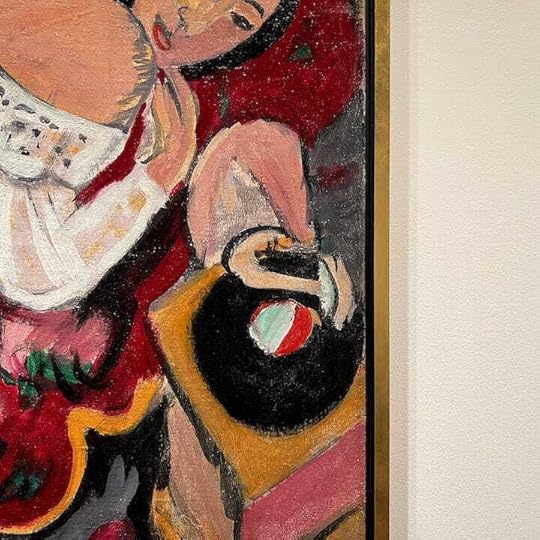
This element was a reminder of just how much sound there is in the work of New York native Jean-Michel Basquiat (1960-1988). The larger piece is titled Diagram of the Ankle, from 1982. There is something jittery about the desire to scribble the receptive mechanisms of human hearing, a will to comprehend. This material shown here is a subset of half of a diptych, its background a cream color, adjacent to the other portion’s black, the latter of which features a visually loud, all-caps “WOOFS” next to the faces of some wild-looking dogs — perhaps the very sounds that this anatomical equipment is processing.
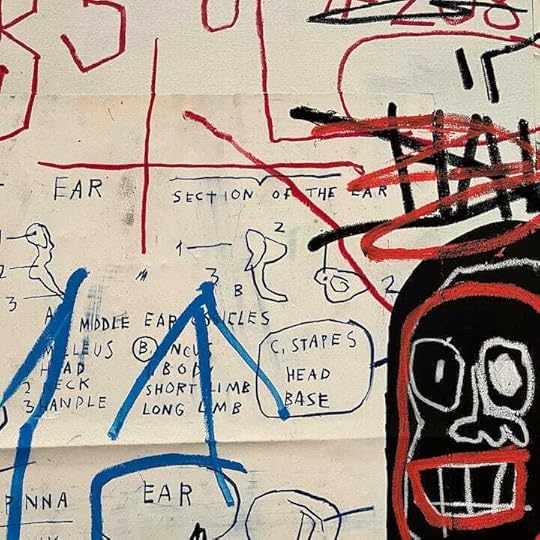
I was confronted by the intense graphic sensibility of another New York native, Roy Lichtenstein (1923-1997). The instant I took this photo, I was faced with the shortcomings of its resulting depiction of the piece’s surface, even when I zoomed in. Then I recalled that I spend too much time thinking about a central irony of Lichtenstein’s work: reproduction doesn’t begin to do it justice. This is from the onomatopoeically named Blam, from 1962. It’s funny to think that one common trope in the description of Lichtenstein’s work is that he “elevates” his source material, in this case a panel from a comic of the same year by artist Russ Heath (1926-2018). It’s arguable that Lichtenstein’s take is, in fact, more cartoony, not less, than the Heath original, which has more doom-laden colors and a far less abstract explosion. And as for “BLAM” itself, it is softer and more rounded in Lichtenstein’s rendering.
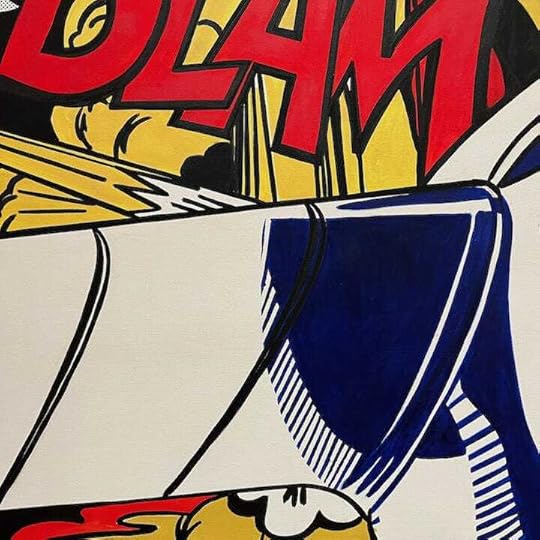
TWiS Listening Post (0003)
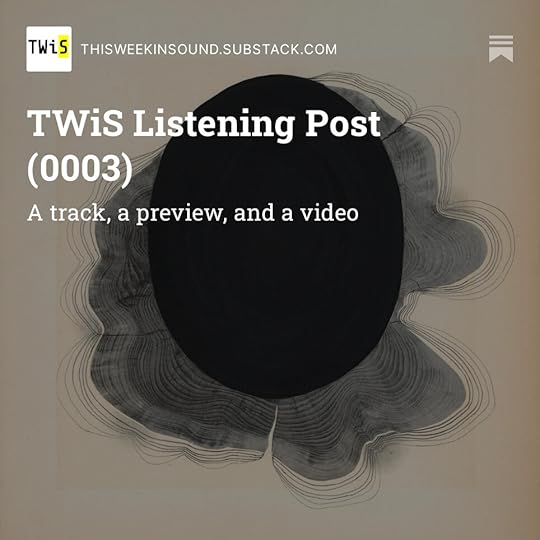
This went out today as a thank you to paid This Week in Sound subscribers: an annotated playlist of recommended music (from Jeannine Schulz, Snorri Hallgrímsson, and Davide Bernardi).



